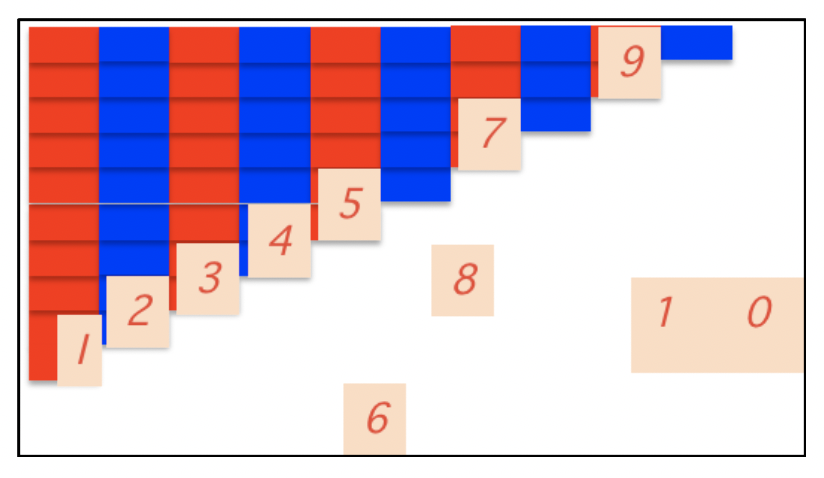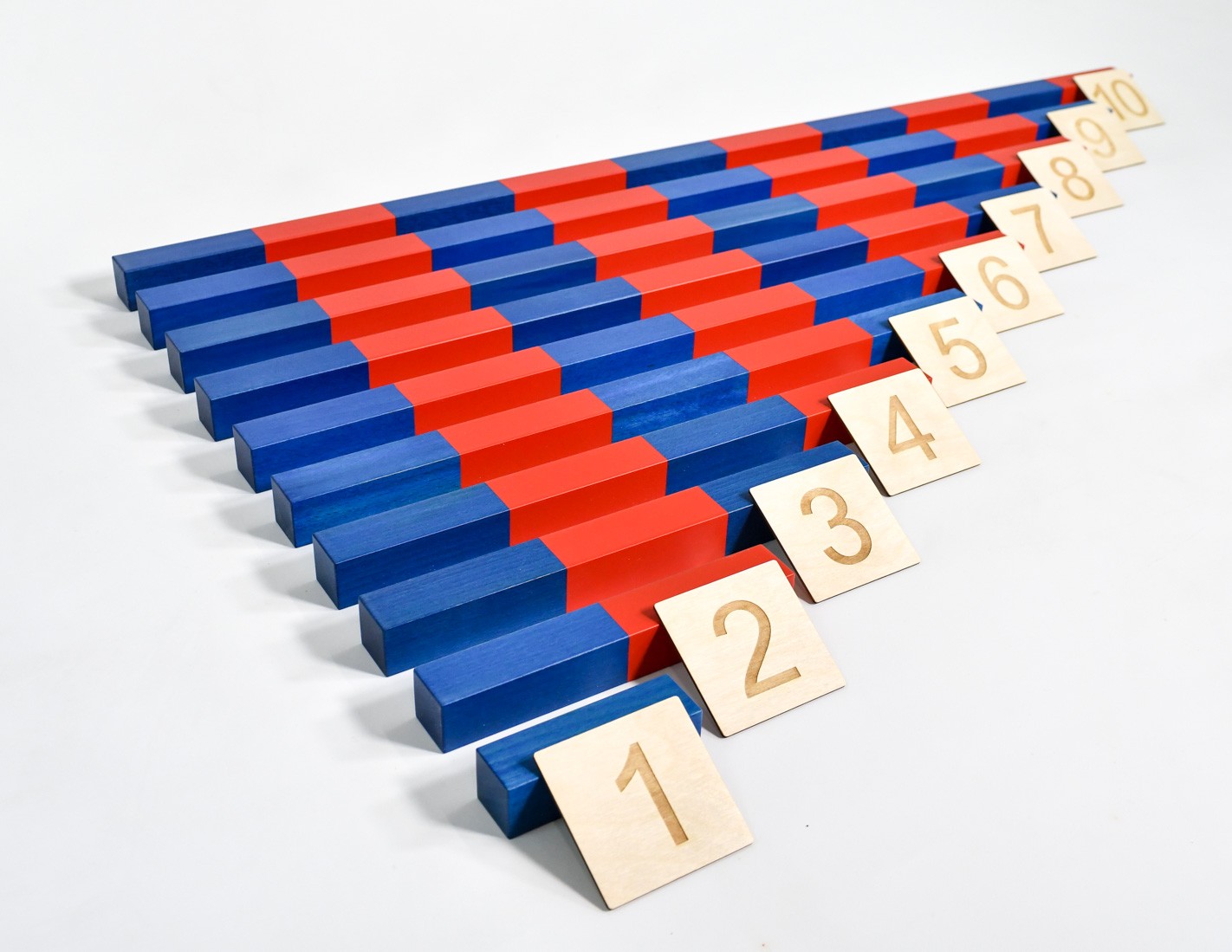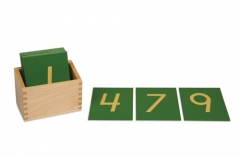Introducing Numbers 0 to 10 “Rarely, however, can he count with the fingers of one hand, and when he succeeds in doing this, there is always the difficulty of knowing why,…..the extreme exactness and correctness of a child’s mind needs clear and precise help. When numerical rods are given to children, we see that even the smallest take a lively interest in counting.”
The Number Rods Introducing Numbers 0 to 10
The Number Rods are ten wooden rods varying in length from 1 decimeter (10 centimeter) to 1 meter (100 centimeters). Each decimeter on every rod is colored (and repeatedly) with red and blue, The first decimeter length of each rod is always red . Thus the first rod is red. The second, which is two decimeters long, is colored red and blue, and so on. These rods are equal in dimensions to the red rods (sensorial material).
Exercise 1:The Number Rods Introductory exercise
MATERIAL
The number rods: A floor mat, preferably sharp green (or any other color not matching with blue or red shades), measuring about 4 feet by 3 feet.
AGE 4 years onwards
PURPOSES
- To introduce the number rods to the children .
- To establish the likeness between long rods and number rods.
- To indirectly enable the children to visualize the successive increase in quantity from 1 to 10 (in terms of length at every successive rod).
EXERCISE
Note: complete work cycle od to be observed
- Set the mat on the floor.
- Bring the rods on the workplace and place them at random horizontally with red ends on the left as shown in the picture on the previous page.
- Introduce the number rods e.g by saying “These are the number rods” Further explain the analogy between the number rods and the long rods e.g. by saying. “Do you remember some material in the classroom that you have used previously, which looks like the number rods?”
- Wait for the response in terms of “red rods” from the child, else , point to the red rods for him.
- Tell the child that the number rods can also be arranged in the same way as the long rods.
- Beginning with the rod of one, arrange the rods in order of length, just like the red rods, with red ends on the left, lined up evenly.
- Allow the child to take over at any stage.

Exercise 2
The number Rods Learning to count from 1 to 10
MATERIAL
Same as in introductory exercise.
PURPOSES
- Introduction to counting 1 – 10.
- To understand the quantitative value/significance of each number.
- To learn the names “one “ to “ten” and to associate the names with the quantities.
- Awareness of the sequence of numbers 1 to 10.
- Awareness of the quantitative relationship between numbers e.g 2 is more than 1 and 3 is more than 2, etc.
Period 1
- Move the first rod close to the child.
- Point towards it and say “This is the rod of one”. Name it several times. “One … this is one.”
- Then, slide the second rod in front of the child and say, “This is the rod of two”. Then count the partitions touching the center of each segment with the forefinger , being careful not to hide the rod with the hand, i.e. point to the red side of the rod and say “one “, and then point to the blue part and say “two”. Repeat a few times
- Then, take the rod of the three and repeat the above steps . Name it several times like above. “Three…three…this is three. ”Finally, count the segments of the . “One…two…three”, touching segments of the rod.
Period 2 :
- Having introduced the first three rods, say “Show me the rod of one”. The child will probably show or handover the rod of one . Then , say “Show me the rod of two” and so on.
- Extend the second period till you are sure the child is ready to move on to period 3.
Period 3:
- Point to any one rod and say “What is this?” and wait for the child to answer.
- At naming a rod correctly, also ask the child to count the rod. For example, place the rod of three in front of him and ask, “How much is this?” Or “What is this?”. If he says “Three” then she asks him to count it. He counted the segments, “One, two, three.” This can be repeated several times with each of the rods.
- On succeeding day, add one or more rods to those already learned, until the child can count all the rods. The rods are left on the shelf for the child to count whenever he likes.

Exercise 3 :Sandpaper Numbers
MATERIAL
Introducing Numbers 0 to 10, Ten green wooden/acrylic cards with the numerals 0 to 9, cut of the finest grade sandpaper, mounted on each card. The format of the numerals must be similar to the numeric writing pattern which the school follows. (Numeral 0 is skipped in this exercise and is presented after working with the Spindle Boxes.)
PURPOSES
- To learn to recognize the written symbol for numbers 0 to 9.
- To associate numerals with their spoken name
- Preparation for writing
AGE4 year and older
EXERCISE
Note : complete work cycle is to be observed.
- Sensitize your and the child’s fingers.
- Move the material to a table(preferably).
- Select the first two to three cards i.e. 1, 2 & 3 and place them towards the top of the table. (Zero is introduced after the child has worked with spindle boxes).
- Using a multisensory approach, involving the child’s sense of sight, touch and hearing, being Three Period Lesson as described on the next page.
Sensitizing Fingertips
Invite the child by telling him that before we can work with the sandpaper numbers, we must clean our hands and sensitize our fingertips.
PRESENTATION
- Take the child over to the sink .
- Wash your hands with soap.
- Fill up a bowl with warm water.
- Put your fingertips of the dominant hand into the water.
- Let them soak for a little while.
- Dry them by rubbing gently against the towel.
- Ask the child to sensitize his finger in the same way.
- Suggest to the child to stimulate his fingertips in the same way in the future.

Period 1
Slit beside the child take this first numerals i.e.
1 , leaving the order numbers to the top side.
- Bring the numeral “1”card in front of you, and holding it steady with your left- hand, gently trace the numeral with the index and middle fingers of your dominant hand in the right way of writing it.
- Trace the numeral three times and each time say its name like, “One … this is one …this is the way we write… ;one.”
- Slide the numeral towards the and say, “would you like to try that?”
- Continue to repeat the name of the numeral each time the child traces the number (if the child is not saying the name at this point, but he may do so spontaneously.
- Male sure that the child traces the numeral in the right direction of writing it, using his dominant hand.
- Slide away the first numeral toward the top of the table, and bring down the numeral 2 in the front.
- Trace it light at least three times and say its name in the same way as you did with numeral ` 1 `. Invite them to try that.
- Put away numeral 2 and repeat the above steps with numeral 3.
Period 2
- Place all numerals in front of the child in the right sequence 1,2,3 from left to right.
- Ask , “Can you show me one?”
- When the child shows you 1, ask him to trace it for you once again .
- Repeat the above question for numerals 2 and 3, asking the child to trace the number each time on showing correctly.
- Change places of the numeral and ask the same questions one by one again.
- Repeat many times till you are sure that child can make the association between all the numerals and their names.
- Extend ‘Period2’ as per requirement.
Period 3
- Place all numerals in front of the child.
- Point to a numeral and say, “What is this?”
- When the child tells you its name ask him to trace that.
- Repeat for all the numerals.
- Ask the child to put the material back, saying, “today we learned to write the numbers 1, 2 and 3”
- Add more numbers in the already learned numbers on subsequent days.
- Leave the box on the shelf and tell the child that he can work with sandpaper numbers anytime he likes.

Exercise 4:Number Rods & Numerals
Material
- The Number rods.
- One set of written wooden/acrylic cards with the numerals 1 to 10 normally in black or red.
- Large felt for floor exercise.
PURPOSES
- To relate the numerals 1 to 10 with the corresponding quantities.
- To see the numerals 1 to 10 in sequence.
AGE 4 years and older
PRELIMINARY STEPS
As the child`s so far, familiar with numerals 1 to 9 only, introduce number 10 by showing the 10 card.
Exercise 1:
Note: Complex work cycle is to be observed Introducing Numbers 0 to 10
- Place the rods and numeral cards at random on the mat.
- Point to a rod and ask the child to count it and then find the corresponding numeral from the number cards. For example, pointing to the rod of three, you ask him to count it. After the child has counted, you ask him to find the number 3 from the cards and place it next to the rod (towards the right end of the rod).
- Continue in the same way till all numerals and rods are associated.
Exercise 2
- Place the rods and numeral cards at random on the mat.
- Ask the child to find rod 1 and the numeral card 1 , and place the card next to the rod.
- Ask the child to continue placing the rest of the numeral cards with the corresponding number rods.
Exercise 3
- Place the rods and numeral cards at random on the mat as in Presentation 1 to 2 .
- Invite the child to build the stairs.
- Point to rod 1 and way, “This is the rod of 1”.
- Then hold the number card of 1 and say, “This is how we write 1”. Place it next to the rod of 1.
- Do the same for rod of 2 and 3 then invite the child to continue.
- Continue till all the cards are placed in the correct sequence from 1 to 10 along with the stair made up of rods.
EXTENSION
Do the Introducing Numbers 0 to 10 exercise some other day in reverse order by showing numerals and asking children to find corresponding rods to place them together.
